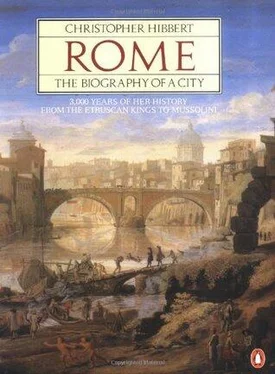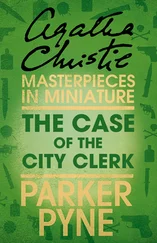Christopher Hibbert - Rome. The Biography of the City
Здесь есть возможность читать онлайн «Christopher Hibbert - Rome. The Biography of the City» весь текст электронной книги совершенно бесплатно (целиком полную версию без сокращений). В некоторых случаях можно слушать аудио, скачать через торрент в формате fb2 и присутствует краткое содержание. Жанр: Культурология, Искусство и Дизайн, на английском языке. Описание произведения, (предисловие) а так же отзывы посетителей доступны на портале библиотеки ЛибКат.
- Название:Rome. The Biography of the City
- Автор:
- Жанр:
- Год:неизвестен
- ISBN:нет данных
- Рейтинг книги:3 / 5. Голосов: 1
-
Избранное:Добавить в избранное
- Отзывы:
-
Ваша оценка:
- 60
- 1
- 2
- 3
- 4
- 5
Rome. The Biography of the City: краткое содержание, описание и аннотация
Предлагаем к чтению аннотацию, описание, краткое содержание или предисловие (зависит от того, что написал сам автор книги «Rome. The Biography of the City»). Если вы не нашли необходимую информацию о книге — напишите в комментариях, мы постараемся отыскать её.
Rome. The Biography of the City — читать онлайн бесплатно полную книгу (весь текст) целиком
Ниже представлен текст книги, разбитый по страницам. Система сохранения места последней прочитанной страницы, позволяет с удобством читать онлайн бесплатно книгу «Rome. The Biography of the City», без необходимости каждый раз заново искать на чём Вы остановились. Поставьте закладку, и сможете в любой момент перейти на страницу, на которой закончили чтение.
Интервал:
Закладка:
Flaminia Beside S. MARIA DEL POPOLO, from which it took its present name of Porta del Popolo. Built into the Aurelian Wall, it opened on to the Via Flaminia which leads out of Rome to the north-east, and which was built by the Censor Caius Flaminius in 220 B.C. Flumentana In the Servian Wall near the Foro Boario between the Palatine and Capitol hills.
Fontinalis In the Servian Wall along a ridge between the Capitol and Quirinal hills. The ridge and gate were removed by Trajan for the building of his forum.
Latina In the Aurelian Wall near the Parco degli Scipioni and beyond the BATHS OF CARACALLA. It opened on to the Via Latina. It was built by Belisarius with a single arch.
Lavernalis Part of the Servian Wall, it was replaced by a bastion by Pope Paul III (1534–49). This bastion is in the Via S. Maria del Priorato which runs down to the river on the slope of the Aventine along the grounds of the Priory of the Knights of Malta.
Metronia In the Aurelian Wall in the Piazza Metronia. The arches still stand but traffic does not pass through them.
Mugonia Said to have been built by Romulus on the Palatine near the ARCH OF TITUS
Naevia In the Servian Wall on the Aventine.
Nomentana In the Aurelian Wall, just east of the Porta Pia. It gave on to the road to Nomentum (Mentana) to the east of Rome. It was walled up in 1564 by Pope Pius IV.
Honoriana Built in 405 by the Emperor Honorius, it stood in what is now the Pizzale Labicano near the Piazza di Porta Maggiore. It was demolished by Pope Gregory XVI in 1838. It led out on to the Via Casilina, the road to Capua (Casilinum).
Ostiensis In the Aurelian Wall on the old Via Ostiensis. It is now called the Porta S. Paolo since it led to the basilica of St Paul outside the Walls. The gate is situated at the end of the Viale del Piramide di Cestio and is very close to the pyramid which was itself incorporated as part of the Aurelian Wall. The outer façade of the gate was added by the Emperor Honorius at the beginning of the fifth century.
Pertusa In the Leonine Wall. It was blocked up by the middle of the nineteenth century.
Pia The last architectural design by Michelangelo. It was built between 1561 and 1564 near the Porta Nomentana. It closes the upper end of the Via XX Settembre. It is flanked on the right by the gardens of the British Embassy (now the Chancery only) and on the left by the Villa Paolina once owned by Napoleon's sister, Pauline Borghese, and now the French Embassy to the Holy See. It was near this gate that the Italian army of King Victor Emmanuel II under General Cadorna stormed the Aurelian Wall and entered Rome on 20 September 1870. It now houses the Bersaglieri Museum.
Pinciana See Belisaria.
del Popolo See Flaminia.
Portese Built by Pope Urban VIII (1623–44). It stands on the right bank of the Tiber at the south end of the Borgo near the Ponte Sublicio.
Portuensis Built by the Emperors Arcadius and Honorius in the early fifth century near the Porta Portese. It marked the beginning of the Via Portuense which led to Porto, the port of Rome at the mouth of the Tiber established by Claudius in A.D. 42. It was demolished by Urban VIII.
Praenestina See Maggiore.
Praetoria The main entrance into the vast compound of the Castro Pretorio which was built in A.D. 23 by Tiberius's minister, Sejanus, to house the Praetorian Guard and which is still a barracks today.
Querquetulana In the Servian Wall on the Caelian hill.
Quirinalis In the Servian Wall on the north-west slope of the Quirinal hill.
Ratumena In the Servian Wall at the foot of the Capitol. It has been identified with the Porta Fontinalis. It seems also to have been called Porta Pandana.
Raudusculana In the Servian Wall on the Aventine at a point where the Viale Aventino now widens into Piazza Albania.
Romana Said to have been built by Romulus on the Palatine near the Velabro.
Salaria A northern gate in the Aurelian Wall, the outlet for the famous salt way or Via Salaria. It led to the port of Ascoli Piceno (Truentum). It was demolished in 1874 according to Gregorovius's diaries. It was here that Alaric and his Goths broke into Rome in A.D. 410.
Salutaris and Sanqualis Two gates in the Servian Wall on the north-western slope of the Quirinal.
S. Giovanni Inserted in the Aurelian Wall close to St John Lateran by Iacopo del Duca in 1574 for Pope Gregory XIII. It opens on to the Piazzale Appio where the Via Appia Nuova begins.
S. Pancrazio On the highest point of the janiculum on the site of the ancient Porta Aurelia. It has also been called Porta del Gianicolo. The scene of fierce fighting during Garibaldi's defence of the Roman Republic, it was rebuilt in 1854.
S. Paolo See Ostiense.
S. Sebastiano In the Aurelian Wall on the Via Porta di S. Sebastiano. It was first called the Porta Appia and led on to the old Appian Way. It was rebuilt in the early fifth century by the Emperor Honorius and restored in the sixth century by Justinian's generals, Belisarius and Narses.
S. Spirito On the right bank of the Tiber, on the south boundary of the Borgo near the Ospedale del S. Spirito. It was built about 1540 by Antonio da Sangallo the younger of Florence for Pope Paul III.
Settimiana Opened by Alexander VI (1492–1503) in a section of the Aurelian Wall where there had been a postern gate. It is at the south end of the Via della Lungara by the Museo Torlonia.
Tiburtina Originally built by Augustus on the Via Tiburtina leading to Tivoli (Tibur). It was incorporated in the Aurelian Wall when this was built in 271–5. It was repaired by Honorius in 403.
Torrione See Cavalleggeri.
Trigermina In the Servian Wall close to the Pons Probi between the CIRCUS MAXIMUS and the Aventine.
Viminalis In the Servian Wall half-way between the Porta Collina and the Porta Esquilina.
3. The Laterani family are known to have owned a palace on the Caelian hill which was confiscated by Nero after their implication in an anti-imperial plot. St Optatus mentions the palace as the property of Fausta, the second wife of Constantine. There is no record of a conveyance or donation of the property to the Church, though there is a very early tradition of a gift by the Emperor to Pope Sylvester 1(314–35). It is probable that the first residence of the popes at the LATERAN PALACE was in one of the then existing buildings. Subsequently new buildings were erected and by the time of Pope Damasus (366–84) residence at the Lateran had come to be accepted as a sign of legitimacy. The first palace at the Lateran erected by a pope as a papal residence was the imposing mass of buildings called the Patriarchio of Leo III (795–816) which included a richly decorated banqueting hall of great size. This was destroyed by fire in 1308. When the popes returned from Avignon in 1377 they took up residence at the VATICAN and it was not until 1586, as part of a restoration of the whole Lateran area, that Pope Sixtus V (1585–90) employed Domenico Fontana to build the new papal palace. The BAPTISTERY too is not the original. It appears that, before the Baptistery built by Constantine, there had already been two such buildings on the site. Constantine's Baptistery was replaced by another built by Pope Sixtus III (432–40) which, with later changes, especially by Urban VIII in 1637, is the one we see today. This contains the huge green basalt urn in which Cola di Rienzo immersed himself on the festival of 1 August 1347 (see Chapter 6).
4. The SANCTA SANCTORUM, dedicated to St Laurence, was at first the private chapel of the popes in the LATERAN PALACE. It was restored by Pope Nicholas III (1277–80). The building, which now contains the chapel and the steps leading up to it, the SCALA SANTA, was built by Domenico Fontana for Pope Sixtus V (1585–90).
Читать дальшеИнтервал:
Закладка:
Похожие книги на «Rome. The Biography of the City»
Представляем Вашему вниманию похожие книги на «Rome. The Biography of the City» списком для выбора. Мы отобрали схожую по названию и смыслу литературу в надежде предоставить читателям больше вариантов отыскать новые, интересные, ещё непрочитанные произведения.
Обсуждение, отзывы о книге «Rome. The Biography of the City» и просто собственные мнения читателей. Оставьте ваши комментарии, напишите, что Вы думаете о произведении, его смысле или главных героях. Укажите что конкретно понравилось, а что нет, и почему Вы так считаете.












